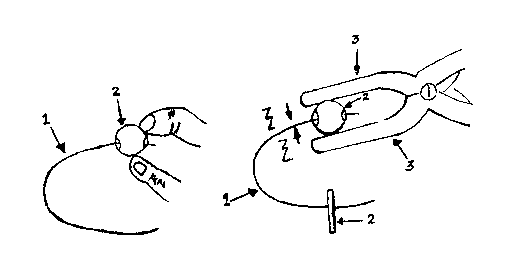Une partie des informations de ce site Web a été fournie par des sources externes. Le gouvernement du Canada n'assume aucune responsabilité concernant la précision, l'actualité ou la fiabilité des informations fournies par les sources externes. Les utilisateurs qui désirent employer cette information devraient consulter directement la source des informations. Le contenu fourni par les sources externes n'est pas assujetti aux exigences sur les langues officielles, la protection des renseignements personnels et l'accessibilité.
L'apparition de différences dans le texte et l'image des Revendications et de l'Abrégé dépend du moment auquel le document est publié. Les textes des Revendications et de l'Abrégé sont affichés :
| (12) Demande de brevet: | (11) CA 2632666 |
|---|---|
| (54) Titre français: | METHODE ET TROUSSE COMPRENANT DES ELEMENTS D'ARRET POUR LE TRAITEMENT DE MALOCCLUSIONS DENTAIRES AU MOYEN D'ARCS PREFORMES EN NITINOL |
| (54) Titre anglais: | METHOD AND KIT WITH TOPS FOR THE CORRECTION OF DENTAL MALOCLUSIONES WITH PREFORMED ARCS OF NITINOL |
| Statut: | Réputée abandonnée et au-delà du délai pour le rétablissement - en attente de la réponse à l’avis de communication rejetée |
| (51) Classification internationale des brevets (CIB): |
|
|---|---|
| (72) Inventeurs : |
|
| (73) Titulaires : |
|
| (71) Demandeurs : |
|
| (74) Agent: | MBM INTELLECTUAL PROPERTY AGENCY |
| (74) Co-agent: | |
| (45) Délivré: | |
| (86) Date de dépôt PCT: | 2005-12-06 |
| (87) Mise à la disponibilité du public: | 2007-06-14 |
| Licence disponible: | S.O. |
| Cédé au domaine public: | S.O. |
| (25) Langue des documents déposés: | Anglais |
| Traité de coopération en matière de brevets (PCT): | Oui |
|---|---|
| (86) Numéro de la demande PCT: | PCT/MX2005/000113 |
| (87) Numéro de publication internationale PCT: | MX2005000113 |
| (85) Entrée nationale: | 2008-06-06 |
| (30) Données de priorité de la demande: | S.O. |
|---|
L'invention concerne un procédé et un kit de correction de malpositions dentaires, qui comprend au moins un arc préformé pour orthodontie au nitinol, au moins deux sphères en argent perforées qui se fixent solidement à l'arc après leur introduction dans l'arc et leur déformation de manière à servir de butées. Le procédé comprend l'assemblage de l'invention, l'alignement des dents grâce à l'arc dentaire préformé au nitinol présentant des butées plaquées contre celui-ci, la fermeture d'espaces, le nivellement, le précouplage et le couplage.
The invention relates to a method and a kit for correcting dental
malocclusions. The inventive kit consists of at least one pre-formed arch for
nitinol orthodontics and at least two perforated silver spherules which when
introduced into the arch and deformed remain fixed to the arch, serving as a
stop element. The inventive method consists in: positioning the necessary
elements; aligning the teeth with the application of the preformed nitinol
dental arch, having stop elements abutting thereagainst; closing the spaces;
performing a levelling step; and applying a pretorque and a torque.
Note : Les revendications sont présentées dans la langue officielle dans laquelle elles ont été soumises.
Note : Les descriptions sont présentées dans la langue officielle dans laquelle elles ont été soumises.

2024-08-01 : Dans le cadre de la transition vers les Brevets de nouvelle génération (BNG), la base de données sur les brevets canadiens (BDBC) contient désormais un Historique d'événement plus détaillé, qui reproduit le Journal des événements de notre nouvelle solution interne.
Veuillez noter que les événements débutant par « Inactive : » se réfèrent à des événements qui ne sont plus utilisés dans notre nouvelle solution interne.
Pour une meilleure compréhension de l'état de la demande ou brevet qui figure sur cette page, la rubrique Mise en garde , et les descriptions de Brevet , Historique d'événement , Taxes périodiques et Historique des paiements devraient être consultées.
| Description | Date |
|---|---|
| Demande non rétablie avant l'échéance | 2009-12-07 |
| Le délai pour l'annulation est expiré | 2009-12-07 |
| Réputée abandonnée - omission de répondre à un avis sur les taxes pour le maintien en état | 2008-12-08 |
| Inactive : Page couverture publiée | 2008-09-26 |
| Inactive : Inventeur supprimé | 2008-09-24 |
| Exigences relatives à une correction d'un inventeur - jugée conforme | 2008-09-24 |
| Inactive : Notice - Entrée phase nat. - Pas de RE | 2008-09-24 |
| Inactive : CIB en 1re position | 2008-07-04 |
| Demande reçue - PCT | 2008-07-03 |
| Inactive : IPRP reçu | 2008-06-07 |
| Déclaration du statut de petite entité jugée conforme | 2008-06-06 |
| Exigences pour l'entrée dans la phase nationale - jugée conforme | 2008-06-06 |
| Demande publiée (accessible au public) | 2007-06-14 |
| Date d'abandonnement | Raison | Date de rétablissement |
|---|---|---|
| 2008-12-08 |
Le dernier paiement a été reçu le 2008-06-06
Avis : Si le paiement en totalité n'a pas été reçu au plus tard à la date indiquée, une taxe supplémentaire peut être imposée, soit une des taxes suivantes :
Les taxes sur les brevets sont ajustées au 1er janvier de chaque année. Les montants ci-dessus sont les montants actuels s'ils sont reçus au plus tard le 31 décembre de l'année en cours.
Veuillez vous référer à la page web des
taxes sur les brevets
de l'OPIC pour voir tous les montants actuels des taxes.
| Type de taxes | Anniversaire | Échéance | Date payée |
|---|---|---|---|
| Taxe nationale de base - petite | 2008-06-06 | ||
| TM (demande, 2e anniv.) - petite | 02 | 2007-12-06 | 2008-06-06 |
Les titulaires actuels et antérieures au dossier sont affichés en ordre alphabétique.
| Titulaires actuels au dossier |
|---|
| GRACIELA LANDEROS RAMIREZ |
| Titulaires antérieures au dossier |
|---|
| S.O. |